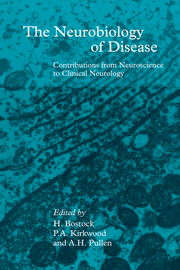Book contents
- Frontmatter
- Contents
- List of contributors
- Preface
- Part I Physiology and pathophysiology of nerve fibres
- 1 Ion channels in normal and pathophysiological mammalian peripheral myelinated nerve
- 2 Molecular anatomy of the node of Ranvier: newer concepts
- 3 Delayed rectifier type potassium currents in rabbit and rat axons and rabbit Schwann cells
- 4 Axonal signals for potassium channel expression in Schwann cells
- 5 Ion channels in human axons
- 6 An in vitro model of diabetic neuropathy: electrophysiological studies
- 7 Autoimmunity at the neuromuscular junction
- 8 Immunopathology and pathophysiology of experimental autoimmune encephalomyelitis
- 9 Pathophysiology of human demyelinating neuropathies
- 10 Conduction properties of central demyelinated axons: the generation of symptoms in demyelinating disease
- 11 Mechanisms of relapse and remission in multiple sclerosis
- 12 Glial transplantation in the treatment of myelin loss or deficiency
- Part II Pain
- Part III Control of central nervous system output
- Part IV Development, survival, regeneration and death
- Index
8 - Immunopathology and pathophysiology of experimental autoimmune encephalomyelitis
from Part I - Physiology and pathophysiology of nerve fibres
Published online by Cambridge University Press: 04 August 2010
- Frontmatter
- Contents
- List of contributors
- Preface
- Part I Physiology and pathophysiology of nerve fibres
- 1 Ion channels in normal and pathophysiological mammalian peripheral myelinated nerve
- 2 Molecular anatomy of the node of Ranvier: newer concepts
- 3 Delayed rectifier type potassium currents in rabbit and rat axons and rabbit Schwann cells
- 4 Axonal signals for potassium channel expression in Schwann cells
- 5 Ion channels in human axons
- 6 An in vitro model of diabetic neuropathy: electrophysiological studies
- 7 Autoimmunity at the neuromuscular junction
- 8 Immunopathology and pathophysiology of experimental autoimmune encephalomyelitis
- 9 Pathophysiology of human demyelinating neuropathies
- 10 Conduction properties of central demyelinated axons: the generation of symptoms in demyelinating disease
- 11 Mechanisms of relapse and remission in multiple sclerosis
- 12 Glial transplantation in the treatment of myelin loss or deficiency
- Part II Pain
- Part III Control of central nervous system output
- Part IV Development, survival, regeneration and death
- Index
Summary
Introduction
Experimental autoimmune encephalomyelitis (EAE) is an inflammatory demyelinating disease of the central nervous system (CNS), and is widely studied as an animal model of the human CNS demyelinating diseases, including multiple sclerosis (Raine, 1984). EAE can be induced by inoculation with whole CNS tissue, purified myelin basic protein (MBP) or myelin proteolipid protein (PLP), together with adjuvants. It may also be induced by the passive transfer of T cells specifically reactive to these myelin antigens. EAE may have either an acute or a chronic relapsing course. Acute EAE closely resembles the human disease acute disseminated encephalomyelitis, while chronic relapsing EAE resembles multiple sclerosis. EAE is also the prototype for T-cell-mediated autoimmune disease in general. This chapter will focus on the immunopathology and pathophysiology of EAE, which are the subjects of investigation in my laboratory.
Immunopathology
In EAE, activated CD4+ T cells specific for myelin antigens cross the blood–brain barrier and enter the CNS parenchyma. Macrophages, CD4+ T cells of other specificities, and a limited number of B cells and CD8+ T cells also then enter the CNS (Traugott et al., 1981; McCombe et al., 1992). It is generally held that myelin, rather than the oligodendrocyte, is the primary target of the autoimmune attack in EAE (Itoyama & Webster, 1982; Moore, Traugott & Raine, 1984), and that the myelin damage is initiated by macrophages that have been activated by cytokines secreted by the invading T cells.
- Type
- Chapter
- Information
- The Neurobiology of DiseaseContributions from Neuroscience to Clinical Neurology, pp. 75 - 85Publisher: Cambridge University PressPrint publication year: 1996

